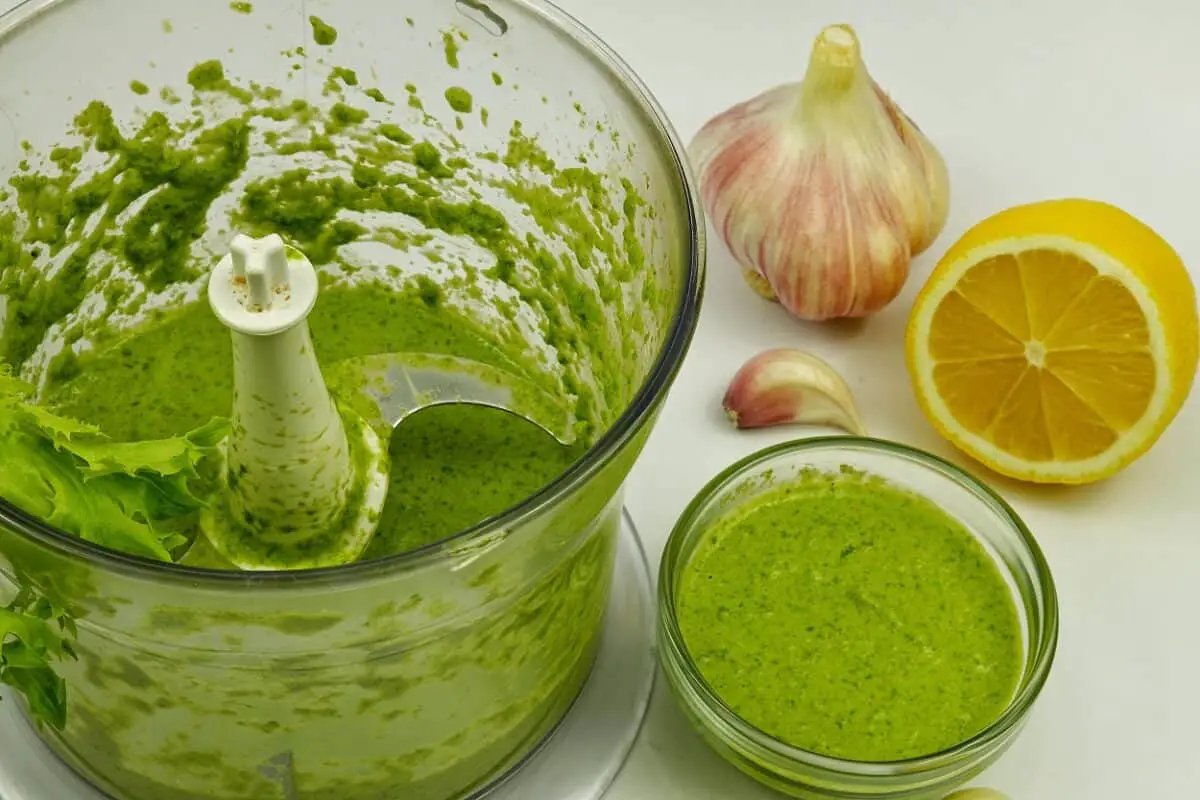Last Updated on 22nd April 2022 by
While some sauces are quick and easy to make and just require mixing up a few ingredients with a whisk, others require a little more effort. Pesto falls into that latter category.
Lot of pesto recipes will call for you to use a food processor to make it. Not everyone has one of those, and then some people want a simpler method to make pesto. I will show you a method for how to make pesto with a blender, which I think is probably the easiest way to make it.
It’s easy partly because the blender tends to be used more. Most people will take out their food processor for special dishes that they only make occasionally. The blender, on the other hand, tends to be a mainstay of the kitchen countertops, used for smoothies, shakes, sauces, and more. You can use it to make pesto as well, and it’s really ePreview Changes (opens in a new tab)asy to make that sauce this way.
Pesto can be used for all sorts of dishes. It’s a great dip for crackers or chips. It’s also a really good spread for pizza and can be used as a sandwich spread as well. You can use it as a sauce to flavor your pasta with as well. It’s pretty versatile and quite healthy, and of course, it’s very flavorful.
I like how you can make pesto in a lot of different ways as well. There’s so many different seasonings that can be added to it. While basil is usually one of the main ingredients, it can be made with parsley, tomatoes, spinach, and more.
How to Make Pesto Sauce with Spinach in a Blender
Ingredients
- 1 cup of basil leaves, packed
- 1 cup of spinach, packed
- ½ cup of extra virgin olive oil
- Juice from 1 lemon
- ⅛ of a teaspoon of salt
- ¼ cup of pine nuts
- ½ cup of parmesan cheese, grated
Instructions
- Put the pine nuts, lemon juice, salt, basil, spinach, parmesan cheese into the blender.
- Set the blender to pulse in order to combine the ingredients. Slowly pour in the olive oil while the blender is pulsing.
- After you have poured in all of the ingredients, continue to blend for another 30 seconds to combine everything smoothly.
There are a few different things you could switch out with the spinach and the basil. You could, of course, make this sauce entirely with basil, leaving out the spinach. You could also mix in kale, and you can you combine these three as desired. Some people will simply make a mix of kale, spinach, and basil based on what they have available to make up the two cups for the sauce.
The pine nuts are another ingredient you could play around with and switch out if you wanted to. The pine nuts can be swapped for pecans, almonds, or walnuts to make pesto that still has that authentic flavor and texture. You can also use sunflower seeds or even pumpkin seeds as a substitute for pine nuts. I know pine nuts can be kind of expensive, so sometimes I do look for a substitute that’s a little cheaper.
You can add some ingredients to the mix as well, such as garlic or sun dried tomatoes. Any kind of tomatoes will work, really, but sun dried tomatoes are considered the most traditional ones to use. You could use Roma, cherry, or other kinds of tomatoes as you like.
How to Make Pesto with a Hand Blender
If you don’t have a large bowl blender, you could also use a stick blender or hand blender to make pesto. It’s a little more work, but the pesto comes out decent anyways.
This kind of blender is also known as an immersion blender, and it works very well for making pesto and other sauces by hand. To make pesto with an immersion blender, you want to put all your ingredients in a mixing bowl at once. This includes the oil, which should be added at the same time as the other ingredients. This will allow the hand mixer to blend everything together more easily.
If your pesto comes out a little too thick, you can add some water to it to thin it out and give it the right consistency. Only add a little bit of water at a time, because it’s easy to add a little water to it but harder to drain out the water without losing some of your pesto ingredients.
How to Make Basil Pesto without a Blender
What if you don’t have a blender or you’d prefer not to use a blender to make pesto? You can make this without a blender, but it’s definitely going to be some work. What you’re going to have to do is mash some of your ingredients down ahead of time before trying to mix them together. So, mash up your nuts or seeds and garlic if you’re using it. Tear the leaves into small pieces or consider using basil since it’s already very small, if you’re using ground basil.
You can mix everything together with a whisk once it’s ground up. I definitely don’t prefer this method, but it works if a whisk is all you have to mix up some pesto with. You don’t have to completely forgo the pesto because you don’t have a blender or your blender is not working. Making it by hand works in a pinch if your blender has breathed its last breath and needs to be replaced. Just remember to add some oil to your recipe to help it mix better. If it’s too thick while you’re mixing it, and you’re getting a lot of resistance, you can add a little water to it to make it easier to mix.
Keep on mixing until everything is combined smoothly and evenly.
No matter which method you are using to make pesto, be sure you taste it before you serve it. It’s not a bad idea to add a little salt to it if it seems kind of bland or if some of the flavors are not very noticeable. Add in a little salt at a time and mix everything around once more, and then taste it to see if it needs more salt.
Your pesto can be stored in the freezer for months until you’re ready to use it again. Simply let it thaw out when you’re ready to add it to salad, pizza, or sandwiches or use it as a dip.
I'm Pauline, a mother of four grown children, my passion for cooking stemmed from the joy i get cooking for my family. I love to try new dishes, especially when dining out but creating and sharing my own recipes is my favourite thing to do!



